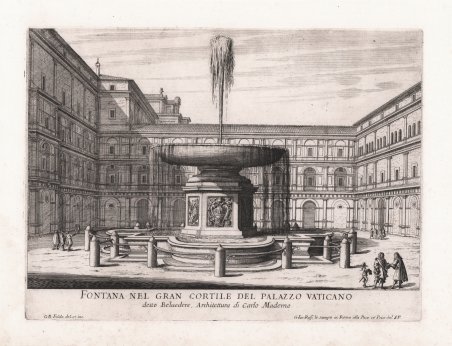Tavola della serie Le Fontane di Roma, edita da Giovanni Giacomo de Rossi alla Pace, senza data ma intorno al 1680. Falda, che muore a Roma nel 1678, incise le tavole del primo e del secondo volume, intitolati rispettivamente dal titolo Le Fontane di Roma nelle Piazze, e luoghi publici della città e Le fontane delle ville di Frascati, nel Tusculano. Le tavole del terzo e quarto volume, Le fontane ne' palazzi e ne' giardini di Roma e Le fontane del giardino Estense in Tivoli, furono, invece, incisi da Giovanni Francesco Venturini. Falda, nativo di Valduggia, all'età di 14 anni fu inviato a Roma ed affidato alle cure di uno zio che lo segnalò a Gian Lorenz Bernini. Ma fu l'incontro con lo stampatore Giovanni Giacomo De Rossi a segnare una svolta nella carriera artistica del Falda: infatti il suo talento venne indirizzato dall'editore all'arte dell'incisione. Il suo tirocinio nella tipografia romana venne benevolmente accolto alla corte papale, tanto che Alessandro VII gli affidò l'incarico di disegnare le fabbriche della residenza di Castel Gandolfo. Nel 1665 Falda diede alle stampe per l'editore De Rossi il suo capolavoro: le tavole del primo libro del Nuovo Teatro delle fabbriche, et edificii, in prospettiva di Roma moderna sotto il felice pontificato di n. s. Alessandro VII, al quale seguirono, tra il 1665 e il '69, il secondo ed il terzo. L'opera aveva lo scopo di divulgare la nuova immagine di Roma: il Papa, infatti, decise di aprire nuove strade, di abbellire con fontane e monumenti la città, anche a dimostrazione della potenza finanziaria e culturale della sua famiglia. Con il Nuovo Teatro, come poi con le successive raccolte dedicate alle fontane e ai palazzi, Falda diventò il divulgatore di questi aspetti; le sue vedute incise, caratterizzate dall'attenzione sia alle regole prospettiche sia agli effetti scenografici, sfruttano abilmente il vigore della linea e la ricchezza del contrasto fra bianco e nero, in sintonia con i criteri spaziali dell'arte barocca. Acquaforte, impressa su carta vergata coeva, in ottimo stato di conservazione. Bibliografia The Illustrated Bartsch, vol. 47/2, pp.4-28. Olschki, Choix, XI, 16899; Rossetti 4830. Plate from the series Le Fontane di Roma, published by Giovanni Giacomo de Rossi alla Pace, undated but before 1680. Falda, who died in Rome in 1678, engraved the plates of the first and second volume, entitled respectively Le Fontane di Roma nelle Piazze, e luoghi publici della città and Le fontane delle ville di Frascati, nel Tusculano. The plates of the third and fourth volume, Le fontane ne' palazzi e ne' giardini di Roma and Le fontane del giardino Estense in Tivoli, were instead engraved by Giovanni Francesco Venturini. Falda, a native of Valduggia, at the age of 14 was sent to Rome and entrusted to the care of an uncle who pointed him out to Gian Lorenz Bernini. But it was the meeting with the printer Giovanni Giacomo De Rossi that marked a turning point in Falda's artistic career: in fact his talent was directed by the publisher to the art of engraving. His apprenticeship in the Roman printing house was well received at the papal court, so that Alexander VII entrusted him with the task of designing the buildings of the residence of Castel Gandolfo. In 1665 Falda printed for the publisher De Rossi his masterpiece: the tables of the first book of the Nuovo Teatro delle fabbriche, et edificii, in prospettiva di Roma moderna sotto il felice pontificato di n. s. Alessandro VII, which was followed, between 1665 and '69, by the second and third books. The work was intended to spread the new image of Rome: the Pope, in fact, decided to open new streets, to embellish the city with fountains and monuments, also to demonstrate the financial and cultural power of his family. With the Nuovo Teatro, as with the subsequent collections dedicated to fountains and palaces, Falda became the popularizer of these aspects. His etched views, characterized by attention to both the rules of perspective and the scenographic effects, skillfully exploit the vigor of the line and the richness of the contrast between black and white, in tune with the spatial criteria of Baroque art. Etching, printed on contemporary laid paper, in excellent condition. Bibliografia The Illustrated Bartsch, vol. 47/2, pp.4-28. Olschki, Choix, XI, 16899; Rossetti 4830. Cfr.


Find out how to use
Find out how to use

